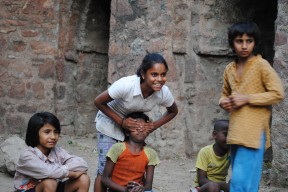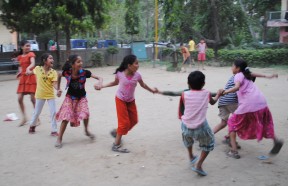Kanchi, Chicklet, Son Pari, Parachute, Pitcher, Gol Chakker, Chunniwala, Mickey Mouse…wondering why we are rambling about these unrelated words? Well, these are just a few names out of the 40 odd games that children of Khirkee village – a semi-urban area of South Delhi – have invented as part of outdoor playing. Nothing unique about this, you are likely to say. As kids, we have all created our own games hidden from the eyes of elders, grazed our knees while playing out the most bizarre routines and enjoyed the outdoors as an essential part of growing up years.
The children of Khirkee, and indeed in most metro cities, however, live in different conditions. They don’t have the advantage of open spaces and adult non-interference. And this is what urban architect and designer Sudeshna Chatterjee discovered on a two-month long project with NGO Khoj, when she got to interact with these kids and discovered that playing outdoors is often trivialized and misunderstood by adults. From the perspective of providing for children’s play, particularly in an urban space, playing outdoors is at best considered a part of formalised structure of recreation, leisure or sports.
Says Chatterjee: “Ordinarily children can and do provide for their own play. However, in the context of a mega city such as Delhi, this right is not so obviously exercised by children anymore. Why I chose Khirkee to study this concept is because Khirkee occupies a unique urban location being on the margins of shiny new mega malls and corporate hospitals. Khirkee’s growing real estate potential is threatening to overwhelm the existing settlement through continuous construction activity by local builders.”
Chatterjee has titled her project Play@Khirkee and believes that this study will help urban planners to make provisions for children with the goal of enhancing the latter’s social participation through play in urban space and city life.
“I discovered that though children love to play outdoors, the constraints of an urban space was killing much of their joy,” says Chatterjee, “for instance, public parks are dominated by those taking walks, or guards who scare the kids away. Sometimes, parents are reluctant to send their children outdoors as they feel they may fall prey to gambling and smoking. Even security is a big issue now. Adults need to make sure they don’t destroy meaningful play spaces and territories that children manage to create out of everyday spaces.”
Studying places of play in Khirkee threw up some other interesting facts as well – slum kids had a bigger repertoire of games compared to those from a middle class background, poorer kids showed far greater imagination when it came to hiding from adults and parents, and most importantly, they didn’t need as many equipments as the more well-off children for playing.
Talking about the future of ‘play’ in an urban context, Chatterjee mentions that we need “playworkers” who facilitate and enrich a child’s play instead of supervisors or security guards who do just the opposite to maintain “beautified landscapes in parks”. “There is a university degree in playwork in the UK now,” she says, “why can’t India have the same concept?”
The second suggestion, and definitely a more radical one, that Chatterjee makes is for society to facilitate the concept of ‘Play-On-Wheels’. “Imagine a cart containing loose parts that could set up play structures in barren playgrounds for under-privileged kids and provide interesting loose parts to middle class children in more rigid, rule bound playgrounds. Such carts can come around each day, be managed by local youth volunteers who serve as playworkers.”
While Khoj has taken the lead and has already planning such a cart that will criss-cross Khirkee area, perhaps it’s time for other members of the civil society to also lend their support. And let the play begin.
An architect and urban designer by training, Sudeshna Chatterjee has a PhD in Community and Environmental Design from NC State University, USA. She works with organizations around the world that are trying to improve children’s living environments besides speaking and advocating for child friendly cities everywhere. Sudeshna delivered a keynote address on the theme of Playing into the Future: Surviving and Thriving at the 50th anniversary World Conference of the International Play Association in Cardiff, Wales on 5th July, 2011.








I appreciate the author’s interest in children. open spaces are indeed required for urban kids too as the evils of video gaming and social networking are creeping in the younger generation.